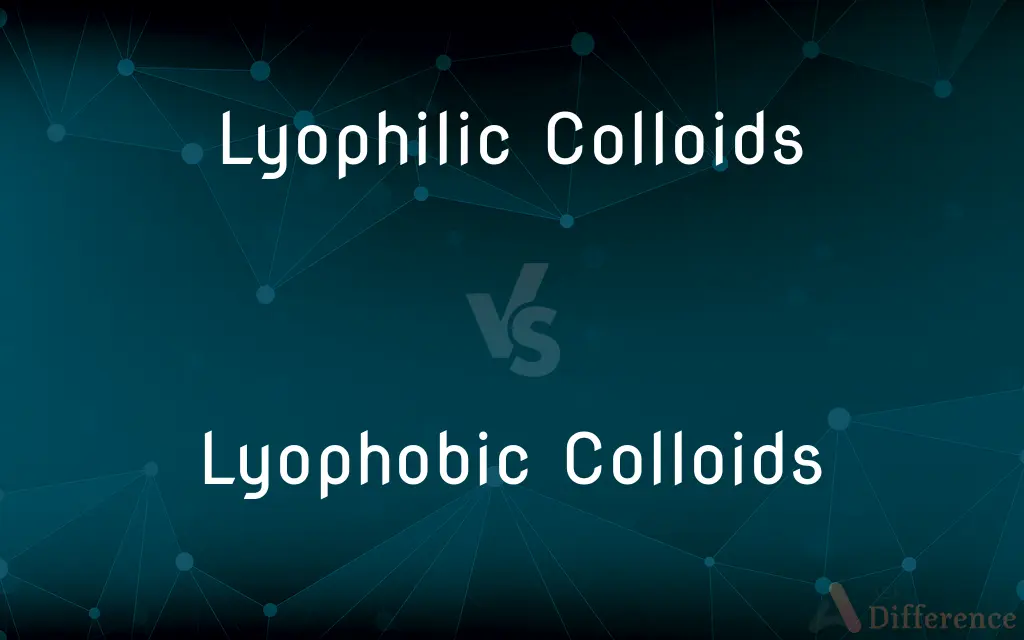Lyophilic Colloids vs. Lyophobic Colloids — What's the Difference?
Edited by Tayyaba Rehman — By Fiza Rafique — Published on December 13, 2023
Lyophilic colloids are solvent-attracting and easily reversible, while lyophobic colloids repel the solvent and are irreversible.

Difference Between Lyophilic Colloids and Lyophobic Colloids
Table of Contents
ADVERTISEMENT
Key Differences
Lyophilic colloids and lyophobic colloids differ in their affinity towards the dispersion medium. Lyophilic colloids have a strong affinity for the dispersion medium, meaning they're solvent-attracting. On the other hand, lyophobic colloids show little to no affinity, making them solvent-repelling.
The stability of lyophilic colloids and lyophobic colloids is another distinguishing factor. Lyophilic colloids are more stable due to their affinity for the dispersion medium. In contrast, lyophobic colloids require special conditions to become stable as they inherently repel the medium.
In terms of preparation, lyophilic colloids can be easily prepared by simply mixing the solute and solvent, given their natural affinity. Conversely, lyophobic colloids require special methods for preparation because they naturally repel the dispersion medium.
When discussing the reversibility of these colloids, lyophilic colloids can be easily reconstituted upon evaporation of the solvent. Lyophobic colloids, however, are irreversible and cannot be reconstituted to their original form once coagulated.
Finally, in the realm of sensitivity, lyophilic colloids show a higher resistance to the addition of electrolytes, unlike lyophobic colloids, which can be easily coagulated by them.
ADVERTISEMENT
Comparison Chart
Affinity to Solvent
High affinity (solvent-attracting)
Low affinity (solvent-repelling)
Stability
Highly stable
Requires special conditions for stability
Preparation
Easily prepared by mixing
Requires special methods
Reversibility
Easily reversible upon solvent evaporation
Irreversible upon coagulation
Sensitivity to Electrolytes
Resistant to added electrolytes
Easily coagulated by electrolytes
Compare with Definitions
Lyophilic Colloids
These colloids are characterized by their solvent-attracting nature.
The protein solutions in our body are examples of lyophilic colloids.
Lyophobic Colloids
These colloids are known for their solvent-repelling characteristics.
Sulphur particles dispersed in water form a lyophobic colloid.
Lyophilic Colloids
They offer high stability due to their inherent affinity for the medium.
Starch solutions remain stable as lyophilic colloids without requiring special conditions.
Lyophobic Colloids
The stability of these colloids requires special conditions.
Metallic sols need protective agents to maintain their stability as lyophobic colloids.
Lyophilic Colloids
Lyophilic colloids resist coagulation when electrolytes are added.
The addition of salt to a gelatin solution does not readily cause coagulation due to its lyophilic colloid nature.
Lyophobic Colloids
Lyophobic colloids have little to no affinity for the dispersion medium.
A gold sol in water is a typical lyophobic colloid.
Lyophilic Colloids
Lyophilic colloids are easily reversible and can be reconstituted upon solvent evaporation.
A gum arabic solution can be reconstituted by adding water, showcasing its lyophilic colloid property.
Lyophobic Colloids
Lyophobic colloids are not easily reversible and remain so once coagulated.
If a gold sol is coagulated, it cannot be brought back to its original state, displaying its lyophobic colloid nature.
Lyophilic Colloids
Lyophilic colloids are colloidal systems with a high affinity for the dispersion medium.
Gelatin in water forms a lyophilic colloid.
Lyophobic Colloids
They can be easily coagulated upon the addition of electrolytes.
Adding just a small amount of salt can coagulate a silver sol due to its lyophobic colloid characteristic.
Common Curiosities
What's the primary difference between lyophilic colloids and lyophobic colloids?
Lyophilic colloids are solvent-attracting, while lyophobic colloids are solvent-repelling.
Can lyophobic colloids be reconstituted after coagulation?
No, lyophobic colloids are typically irreversible once coagulated.
Which colloid is more stable, lyophilic or lyophobic?
Lyophilic colloids are generally more stable due to their affinity for the dispersion medium.
Are lyophobic colloids sensitive to electrolytes?
Yes, lyophobic colloids can be easily coagulated by electrolytes.
How are lyophobic colloids prepared?
They require special methods for preparation, unlike lyophilic colloids which can be simply mixed.
Is a gold sol in water lyophilic or lyophobic?
A gold sol in water is a typical lyophobic colloid.
Are lyophobic colloids solvent-attracting?
No, they are solvent-repelling, unlike lyophilic colloids.
Are lyophilic colloids reversible?
Yes, lyophilic colloids are easily reversible upon solvent evaporation.
What happens when you add electrolytes to lyophilic colloids?
Lyophilic colloids show resistance to added electrolytes and don't coagulate easily.
Can gelatin in water be classified as a lyophobic colloid?
No, gelatin in water is an example of a lyophilic colloid.
Why are lyophobic colloids called "solvent-repelling"?
Because they have little to no affinity for the dispersion medium, making them repel the solvent.
Can lyophilic colloids resist coagulation?
Yes, they resist coagulation, especially when electrolytes are added.
Are lyophobic colloids naturally stable?
No, they require special conditions or agents for stability.
Which colloid is easier to prepare?
Lyophilic colloids, as they can be easily prepared by simple mixing.
Why are lyophilic colloids more stable?
Their high affinity for the dispersion medium grants them higher stability.
Share Your Discovery

Previous Comparison
Right Lung vs. Left Lung
Next Comparison
DNA Viruses vs. RNA VirusesAuthor Spotlight
Written by
Fiza RafiqueFiza Rafique is a skilled content writer at AskDifference.com, where she meticulously refines and enhances written pieces. Drawing from her vast editorial expertise, Fiza ensures clarity, accuracy, and precision in every article. Passionate about language, she continually seeks to elevate the quality of content for readers worldwide.
Edited by
Tayyaba RehmanTayyaba Rehman is a distinguished writer, currently serving as a primary contributor to askdifference.com. As a researcher in semantics and etymology, Tayyaba's passion for the complexity of languages and their distinctions has found a perfect home on the platform. Tayyaba delves into the intricacies of language, distinguishing between commonly confused words and phrases, thereby providing clarity for readers worldwide.











































